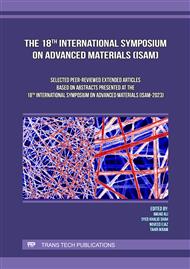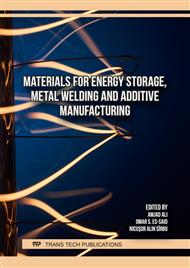[1]
A. S. R. Bati, Y. L. Zhong, P. L. Burn, M. K. Nazeeruddin, P. E. Shaw, and M. Batmunkh, Next-generation applications for integrated perovskite solar cells, Communications Materials, vol. 4, no. 1. 2023.
DOI: 10.1038/s43246-022-00325-4
Google Scholar
[2]
J. Y. Shao et al., Recent progress in perovskite solar cells: material science, Science China Chemistry, vol. 66, no. 1. Science Press (China), p.10–64, Jan. 01, 2023.
DOI: 10.1007/s11426-022-1445-2
Google Scholar
[3]
T. A. Chowdhury, M. A. Bin Zafar, M. Sajjad-Ul Islam, M. Shahinuzzaman, M. A. Islam, and M. U. Khandaker, Stability of perovskite solar cells: issues and prospects, RSC Advances, vol. 13, no. 3. p.1787–1810, 2023.
DOI: 10.1039/d2ra05903g
Google Scholar
[4]
H. Zhang et al., Improving the stability and performance of perovskite solar cells: Via off-the-shelf post-device ligand treatment, Energy Environ. Sci., vol. 11, no. 8, p.2253–2262, 2018.
DOI: 10.1039/c8ee00580j
Google Scholar
[5]
Q. Zhang and Y. Yin, All-Inorganic Metal Halide Perovskite Nanocrystals: Opportunities and Challenges, ACS Cent. Sci., vol. 4, no. 6, p.668–679, Jun. 2018.
DOI: 10.1021/acscentsci.8b00201
Google Scholar
[6]
L. Liu et al., Grain‐boundary 'patches' by in situ conversion to enhance perovskite solar cells stability, Adv. Mater., vol. 30, no. 29, p.1800544, 2018.
Google Scholar
[7]
A. Kojima, K. Teshima, Y. Shirai, and T. Miyasaka, Organometal halide perovskites as visible-light sensitizers for photovoltaic cells, J. Am. Chem. Soc., vol. 131, no. 17, p.6050–6051, 2009.
DOI: 10.1021/ja809598r
Google Scholar
[8]
J.-G. Kim, J.-H. Lee, S.-I. Na, H. H. Lee, Y. Kim, and H.-K. Kim, Semi-transparent perovskite solar cells with directly sputtered amorphous InZnSnO top cathodes for building integrated photovoltaics, Org. Electron., vol. 78, p.105560, 2020.
DOI: 10.1016/j.orgel.2019.105560
Google Scholar
[9]
Ashif Mohammad and Farhana Mahjabeen, Promises and Challenges of Perovskite Solar Cells: A Comprehensive Review, BULLET J. Multidisiplin Ilmu, vol. 2, no. 5, p.1147–1157, 2023, Accessed: Jun. 26, 2024. [Online]. Available: https://www.journal.mediapublikasi.id/ index.php/bullet/article/view/3685
Google Scholar
[10]
Y. Zhao and K. Zhu, Solution chemistry engineering toward high-efficiency perovskite solar cells, J. Phys. Chem. Lett., vol. 5, no. 23, p.4175–4186, 2014.
DOI: 10.1021/jz501983v
Google Scholar
[11]
W. S. Yang et al., High-performance photovoltaic perovskite layers fabricated through intramolecular exchange, Science (80-. )., vol. 348, no. 6240, p.1234–1237, 2015.
DOI: 10.1126/science.aaa9272
Google Scholar
[12]
Z. Li, M. Yang, J.-S. Park, S.-H. Wei, J. J. Berry, and K. Zhu, Stabilizing perovskite structures by tuning tolerance factor: formation of formamidinium and cesium lead iodide solid-state alloys, Chem. Mater., vol. 28, no. 1, p.284–292, 2016.
DOI: 10.1021/acs.chemmater.5b04107
Google Scholar
[13]
D.-H. Choi, H.-J. Seok, D.-H. Kim, S.-K. Kim, and H.-K. Kim, Thermally-evaporated C60/Ag/C60 multilayer electrodes for semi-transparent perovskite photovoltaics and thin film heaters, Sci. Technol. Adv. Mater., vol. 21, no. 1, p.435–449, 2020.
DOI: 10.1080/14686996.2020.1780472
Google Scholar
[14]
H.-J. Seok et al., Zno: Ga-graded ITO electrodes to control interface between PCBM and ITO in planar perovskite solar cells, Sci. Technol. Adv. Mater., vol. 20, no. 1, p.389–400, 2019.
DOI: 10.1080/14686996.2019.1599695
Google Scholar
[15]
H.-J. Seok and H.-K. Kim, Study of sputtered ITO films on flexible invar metal foils for curved perovskite solar cells, Metals (Basel)., vol. 9, no. 2, p.120, 2019.
DOI: 10.3390/met9020120
Google Scholar
[16]
J.-H. Kim et al., Transparent Sn-doped In2O3 electrodes with a nanoporous surface for enhancing the performance of perovskite solar cells, J. Power Sources, vol. 418, p.152–161, 2019.
DOI: 10.1016/j.jpowsour.2019.02.018
Google Scholar
[17]
J. Yang, B. D. Siempelkamp, D. Liu, and T. L. Kelly, Investigation of CH3NH3PbI3 degradation rates and mechanisms in controlled humidity environments using in situ techniques, ACS Nano, vol. 9, no. 2, p.1955–1963, 2015.
DOI: 10.1021/nn506864k
Google Scholar
[18]
A. M. A. Leguy et al., Reversible hydration of CH3NH3PbI3 in films, single crystals, and solar cells, Chem. Mater., vol. 27, no. 9, p.3397–3407, 2015.
Google Scholar
[19]
B. Hailegnaw, S. Kirmayer, E. Edri, G. Hodes, and D. Cahen, Rain on methylammonium lead iodide based perovskites: possible environmental effects of perovskite solar cells, J. Phys. Chem. Lett., vol. 6, no. 9, p.1543–1547, 2015.
DOI: 10.1021/acs.jpclett.5b00504
Google Scholar
[20]
C. C. Stoumpos, C. D. Malliakas, and M. G. Kanatzidis, Semiconducting tin and lead iodide perovskites with organic cations: phase transitions, high mobilities, and near-infrared photoluminescent properties, Inorg. Chem., vol. 52, no. 15, p.9019–9038, 2013.
DOI: 10.1021/ic401215x
Google Scholar
[21]
B. Conings et al., Intrinsic thermal instability of methylammonium lead trihalide perovskite, Adv. Energy Mater., vol. 5, no. 15, p.1500477, 2015.
Google Scholar
[22]
T. M. Koh et al., Formamidinium-containing metal-halide: an alternative material for near-IR absorption perovskite solar cells, J. Phys. Chem. C, vol. 118, no. 30, p.16458–16462, 2014.
DOI: 10.1021/jp411112k
Google Scholar
[23]
G. E. Eperon, S. D. Stranks, C. Menelaou, M. B. Johnston, L. M. Herz, and H. J. Snaith, Formamidinium lead trihalide: a broadly tunable perovskite for efficient planar heterojunction solar cells, Energy Environ. Sci., vol. 7, no. 3, p.982–988, 2014.
DOI: 10.1039/c3ee43822h
Google Scholar
[24]
S. Pang et al., NH2CH NH2PbI3: An alternative organolead iodide perovskite sensitizer for mesoscopic solar cells, Chem. Mater., vol. 26, no. 3, p.1485–1491, 2014.
DOI: 10.1021/cm404006p
Google Scholar
[25]
N. Pellet et al., Mixed‐organic‐cation Perovskite photovoltaics for enhanced solar‐light harvesting, Angew. Chemie Int. Ed., vol. 53, no. 12, p.3151–3157, 2014.
DOI: 10.1002/anie.201309361
Google Scholar
[26]
J. Lee, D. Seol, A. Cho, and N. Park, High‐efficiency perovskite solar cells based on the black polymorph of HC (NH2) 2PbI3, Adv. Mater., vol. 26, no. 29, p.4991–4998, 2014.
DOI: 10.1002/adma.201401137
Google Scholar
[27]
N. J. Jeon et al., Compositional engineering of perovskite materials for high-performance solar cells, Nature, vol. 517, no. 7535, p.476–480, 2015.
DOI: 10.1038/nature14133
Google Scholar
[28]
A. Binek, F. C. Hanusch, P. Docampo, and T. Bein, Stabilization of the trigonal high-temperature phase of formamidinium lead iodide, J. Phys. Chem. Lett., vol. 6, no. 7, p.1249–1253, 2015.
DOI: 10.1021/acs.jpclett.5b00380
Google Scholar
[29]
D. P. McMeekin et al., A mixed-cation lead mixed-halide perovskite absorber for tandem solar cells, Science (80-. )., vol. 351, no. 6269, p.151–155, Jan. 2016.
DOI: 10.1126/science.aad5845
Google Scholar
[30]
J. Lee, D. Kim, H. Kim, S. Seo, S. M. Cho, and N. Park, Formamidinium and cesium hybridization for photo‐and moisture‐stable perovskite solar cell, Adv. Energy Mater., vol. 5, no. 20, p.1501310, 2015.
DOI: 10.1002/aenm.201501310
Google Scholar
[31]
M. Saliba et al., Cesium-containing triple cation perovskite solar cells: Improved stability, reproducibility and high efficiency, Energy Environ. Sci., vol. 9, no. 6, p.1989–1997, 2016.
DOI: 10.1039/c5ee03874j
Google Scholar
[32]
K. A. Bush et al., Controlling Thin-Film Stress and Wrinkling during Perovskite Film Formation, ACS Energy Lett., vol. 3, no. 6, p.1225–1232, 2018, doi: 10.1021/acsenergylett. 8b00544.
DOI: 10.1021/acsenergylett.8b00544
Google Scholar
[33]
B. Groeneveld, … S. A.-E., and undefined 2020, Stable cesium formamidinium lead halide perovskites: a comparison of photophysics and phase purity in thin films and single crystals, Wiley Online Libr. Groeneveld, S Adjokatse, O Nazarenko, HH Fang, GR Blake, G Portale, H DuimEnergy Technol. 2020•Wiley Online Libr., Accessed: May 08, 2024. [Online]. Available: https://onlinelibrary.wiley.com/doi/abs/
DOI: 10.1002/ente.201901041
Google Scholar
[34]
Z. Hu, H. Xiang, M. Schoenauer Sebag, L. Billot, L. Aigouy, and Z. Chen, Compact layer free mixed-cation lead mixed-halide perovskite solar cells, Chem. Commun., vol. 54, no. 21, p.2623–2626, 2018.
DOI: 10.1039/c7cc06183h
Google Scholar
[35]
S. Prathapani, P. Bhargava, and S. Mallick, Electronic band structure and carrier concentration of formamidinium–cesium mixed cation lead mixed halide hybrid perovskites, Appl. Phys. Lett., vol. 112, no. 9, 2018.
DOI: 10.1063/1.5016829
Google Scholar
[36]
Z. Wang et al., Efficient and air‐stable mixed‐cation lead mixed‐halide perovskite solar cells with n‐doped organic electron extraction layers, Adv. Mater., vol. 29, no. 5, p.1604186, 2017.
DOI: 10.1002/adma.201604186
Google Scholar
[37]
Z. Rong et al., Materials Design Rules for Multivalent Ion Mobility in Intercalation Structures, Chem. Mater., vol. 27, no. 17, p.6016–6021, Sep. 2015.
DOI: 10.1021/acs.chemmater.5b02342
Google Scholar
[38]
K. S. Bhardwaj, S. Rai, Sadanand, P. Lohia, and D. K. Dwivedi, Investigating the performance of mixed cation mixed halide-based perovskite solar cells using various hole-transport materials by numerical simulation, Opt. Quantum Electron., vol. 53, no. 11, p.602, Nov. 2021.
DOI: 10.1007/s11082-021-03262-7
Google Scholar
[39]
L. Q. Xie et al., Understanding the Cubic Phase Stabilization and Crystallization Kinetics in Mixed Cations and Halides Perovskite Single Crystals, J. Am. Chem. Soc., vol. 139, no. 9, p.3320–3323, Mar. 2017.
DOI: 10.1021/jacs.6b12432
Google Scholar
[40]
K. T. Cho et al., Highly efficient perovskite solar cells with a compositionally engineered perovskite/hole transporting material interface, Energy Environ. Sci., vol. 10, no. 2, p.621–627, 2017.
DOI: 10.1039/c6ee03182j
Google Scholar
[41]
S. Heo et al., Origins of High Performance and Degradation in the Mixed Perovskite Solar Cells, Adv. Mater., vol. 31, no. 8, Feb. 2019.
DOI: 10.1002/adma.201805438
Google Scholar
[42]
Y. Huang et al., The Exploration of Carrier Behavior in the Inverted Mixed Perovskite Single-Crystal Solar Cells, Adv. Mater. Interfaces, vol. 5, no. 14, Jul. 2018.
DOI: 10.1002/admi.201800224
Google Scholar
[43]
Y. Zhao et al., Perovskite seeding growth of formamidinium-lead-iodide-based perovskites for efficient and stable solar cells, Nat. Commun., vol. 9, no. 1, 2018.
DOI: 10.1038/s41467-018-04029-7
Google Scholar
[44]
H. J. Snaith, Perovskites: The emergence of a new era for low-cost, high-efficiency solar cells, Journal of Physical Chemistry Letters, vol. 4, no. 21. p.3623–3630, Nov. 07, 2013.
DOI: 10.1021/jz4020162
Google Scholar
[45]
P. Saint-Cast et al., High-efficiency c-si solar cells passivated with ALD and PECVD aluminum oxide, IEEE Electron Device Lett., vol. 31, no. 7, p.695–697, 2010.
DOI: 10.1109/LED.2010.2049190
Google Scholar
[46]
S. K. Hau, H. L. Yip, O. Acton, N. S. Baek, H. Ma, and A. K. Y. Jen, Interfacial modification to improve inverted polymer solar cells, J. Mater. Chem., vol. 18, no. 42, p.5113–5119, 2008.
DOI: 10.1039/b808004f
Google Scholar
[47]
Y. H. Lee et al., Enhanced Charge Collection with Passivation Layers in Perovskite Solar Cells, Adv. Mater., vol. 28, no. 20, p.3966–3972, May 2016.
DOI: 10.1002/adma.201505140
Google Scholar
[48]
F. Giordano et al., Enhanced electronic properties in mesoporous TiO2 via lithium doping for high-efficiency perovskite solar cells, Nat. Commun., vol. 7, no. 1, p.1–6, Jan. 2016.
DOI: 10.1038/ncomms10379
Google Scholar
[49]
Y. Shao, Z. Xiao, C. Bi, Y. Yuan, and J. Huang, Origin and elimination of photocurrent hysteresis by fullerene passivation in CH3NH3PbI3 planar heterojunction solar cells, Nat. Commun., vol. 5, no. 1, p.1–7, Dec. 2014.
DOI: 10.1038/ncomms6784
Google Scholar
[50]
J. H. Heo et al., Efficient inorganic-organic hybrid heterojunction solar cells containing perovskite compound and polymeric hole conductors, Nat. Photonics, vol. 7, no. 6, p.486–491, 2013.
DOI: 10.1038/nphoton.2013.80
Google Scholar
[51]
M.P. Eng et al., Elucidating the charge carrier separation and working mechanism of CH3NH3PbI3−xClx perovskite solar cells, J. Phys. Chem. Lett., vol. 5, no. 3461, p.3096–3100, 2014, Accessed: Jun. 02, 2024. [Online]. Available: https://www.nature.com/articles/ ncomms4461
DOI: 10.1038/ncomms4461
Google Scholar
[52]
O. Von Roos, A simple theory of back surface field (BSF) solar cells, J. Appl. Phys., vol. 49, no. 6, p.3503–3511, 1978.
DOI: 10.1063/1.325262
Google Scholar
[53]
K. Masuko et al., Achievement of more than 25% conversion efficiency with crystalline silicon heterojunction solar cell, IEEE J. Photovoltaics, vol. 4, no. 6, p.1433–1435, 2014.
DOI: 10.1109/JPHOTOV.2014.2352151
Google Scholar
[54]
I. J. Kramer, L. Levina, R. Debnath, D. Zhitomirsky, and E. H. Sargent, Solar cells using quantum funnels, Nano Lett., vol. 11, no. 9, p.3701–3706, Sep. 2011.
DOI: 10.1021/nl201682h
Google Scholar
[55]
J. Y. Kim et al., Single-step fabrication of quantum funnels via centrifugal colloidal casting of nanoparticle films, Nat. Commun., vol. 6, 2015.
DOI: 10.1038/ncomms8772
Google Scholar
[56]
M. Burgelman, P. Nollet, S. Degrave, Modelling polycrysta... - Google Scholar. Accessed: May 18, 2024. [Online]. Available: https://scholar.google.com.pk/scholar?hl=en&as_sdt=0%2C5&as_vis=1&q=M.+Burgelman%2C+P.+Nollet%2C+S.+Degrave%2C+Modelling+polycrystalline+semiconductor++solar+cells%2C+ Thin+Solid+Films+361+%282000%29+527–532%2C+https%3A%2F%2Fdoi.org% 2F10.1016%2FS0040-++609
DOI: 10.1016/s0040-6090(99)00825-1
Google Scholar
[57]
Y. H. Lee, S. H. Im, J. A. Chang, J. H. Lee, and S. Il Seok, CdSe-sensitized inorganic-organic heterojunction solar cells: The effect of molecular dipole interface modification and surface passivation, Org. Electron., vol. 13, no. 6, p.975–979, 2012.
DOI: 10.1016/j.orgel.2012.02.011
Google Scholar



